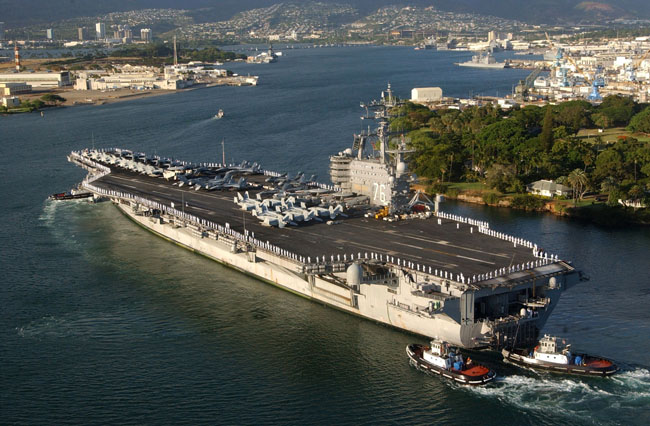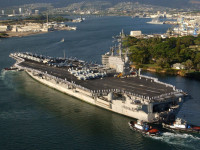

The Center for Strategic and International Studies (CSIS) included the Australian-basing concept as only one option the US might pursue in support of the Obama administration’s plan to emphasize the strategic importance of the Pacific. The report proposes moving a strike group based on the US east coast to Australia’s west coast as a means of bolstering the American military presence in the Asia-Pacific region.
The CSIS report, prepared for the US Department of Defense (DoD), also noted that the Perth naval base, HMAS Stirling, is not presently equipped to support an aircraft carrier strike group. For HMAS Stirling to accommodate a force that would routinely include an aircraft carrier, aircraft, support ships, and guided-missile destroyers and cruisers would likely cost billions of dollars.
Australian Defense Minister Stephen Smith told news sources that that the United States does not currently have a permanent base in Australia and declared that situation was not going to change anytime in the near future. He made it clear that the US may be authorized increased naval access to HMAS Stirling in the long-run, but that would not include the basing of a carrier group there.
Minister Smith said that the government did not see a need for permanent US-basing in Australia. He said that Canberra and Washington were discussing ways to “increase U.S. navy access to HMAS Stirling” and emphasized that “either increased aerial access or naval access is precisely that — greater access to our facilities. It would never become a U.S. military base.”
For many years, the United States maintained three military intelligence communication facilities in Australia. All but one eventually closed due to protests organized by anti-American activists. The Joint Defense Space Research Facility, a top secret site, located in central Australian is the only facility remaining in operation.
Late last year, the US and Australia announced that they had reached an agreement to allow for the rotation of as many as 2,500 US Marines through a joint training facility near Darwin and authorized increased US Air Force access to Australian airfields and bombing ranges as part of a growing military cooperative effort between the two long-term allies.
The People’s Republic of China (PRC) has long protested the flourishing friendship between Washington and Canberra and is anxious to keep the US out of the Pacific whenever and wherever possible. As Australia’s largest trading partner, China does wield significant influence with the Canberra administration.
Also included in the CSIS report is a discussion of alternative options the US might wish to pursue to strengthen its military presence in the Pacific region. One option mentioned the staging of a fully-staffed Marine Air Ground Task Force (MAGTF) in Australia’s Northern Territories, another idea that is not likely to receive favorable consideration in Canberra.
Bob Carr, Australia’s Foreign Minister, supported Minister Smith’s sentiments when he rejected the possibility of establishing a permanent US military presence in Australia. Minister Carr said that the US was not in a position to build a permanent base in Australia in light of impending budget cuts and because such a move would be out of character with the manner the US prefers to “project power.” Mr. Carr also pointed out that a permanent US presence would not be in Australia’s best interest.
Minister Carr went on to say that Canberra was quite aware of China’s growing military and economic strength and was resigned to accept that fact as a reality Australia could not alter. He continued by saying that the Chinese “must accept that we are a small population holding a large continent and will, as we have done historically, look to an alliance with the United States” to protect Australian interests. He further stated that Australia completely rejects “any notion of containing China. We look to engage with China.”
















